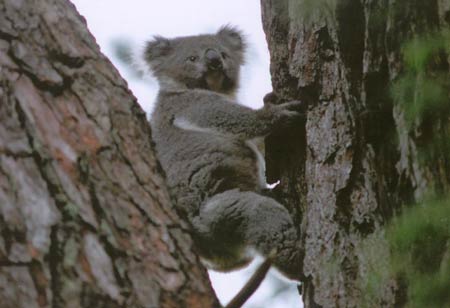

"In Victoria there is now relatively little overlap between commercial timber harvesting and key koala habitat. Exceptions to this include; *hardwood plantation forestry in the Strzelecki Ranges... Victoria's Koala Management Strategy Biodiversity and Natural Resources Division - Department Sustainability and Environment September 2004.
"Between 600 & 800 hectares of Mountain Ash reforestation was logged by Grand Ridge Plantations in the year 2004-5. All of this was potential koala habitat." Anthony Amis Friends of the Earth Melbourne
A strategic framework for native vegetation management is provided in Victoria's Vegetation Management Framework (Department of Natural Resources and Environment 2002) and in native vegetation plans prepared by Catchment Management Authorities. The Native Vegetation Retention Controls, established under the Planning and Environment Act 1987, are also an important policy tool for habitat protection when a development or change in land use is proposed on freehold land... " Victoria's Koala Management Strategy Biodiversity and Natural Resources Division - Department Sustainability and Environment September 2004.
In 1993 the Victorian Government enacted the Victorian Plantations Corporation Act. In 1996 a review of the Code of Forest Practices was completed by the Victorian Government. In the Code it was stated that land under the control of the Victorian Plantations Corporation would be treated as private land. Monitoring of Logging prescriptions on private land is the responsibility of Local Government. Four shires therefore have responsibility for monitoring compliance for the Code of forest Practice in the Strzelecki Ranges; Baw Baw Shire, LaTrobe Shire, South Gippsland Shire and Wellington Shire.
Over half of the Strzelecki Koala sitings since 1990, have been found on private land under the management of Hancock Victorian Plantations and their subsidiary Grand Ridge Plantations.
According to their website Hancock claim;
"The local community is very interested in koala habitat in this region. The scientific community regards the Strzelecki Koala population as making an important contribution to the national Koala gene pool.
HVP's decision not to log native forest, and to protect the native forests under its control, will assist in koala habitat management.
Also to help protect koala populations, the company is working with the AKF (Australian Koala Foundation) and major zoos in North America in a survey of Strzelecki koala populations."
Hancock therefore make no statements about their intention in logging of almost 15,000 hectares of reforested koala habitat over the following decade. One quarter of koala sitings in the Strzelecki and South Gippsland regions since 1990 have been recorded on reforested land defined as being hardwood plantation. It also appears that Hancock have not generated a Koala Management Plan, although the local public has requested copies. This probably is a breach of protocols under the Forest Stewardship Council. Hancock also have claimed that they are conducting research into the habitat needs of the Strzelecki Koala through specific Koala Management and Research Programs.
As late as January 2007 Hancock have stated: "We do not have a Specific BMP for Koala's. Grand Ridge Plantations is currently working with the Australian Koala Foundation on a Koala Management Plan. This project is awaiting the completion of the current EVC mapping project in the Strzelecki ranges." Owen Trumper Manager Grand Ridge Plantations January 22, 2007.
FSC Audits
Hancock is currently certified by the Forest Stewardship Council. According to the Smartwood document; "Forest Management Public Summary for Hancock Victorian Plantations Pty Ltd (Certification Code: SW-FM/COC-1128 update Sep2005),
p57 "Further work is also being carried out by the Australian Koala Foundation to detail Koala habitat in the Strzelecki Ranges and a draft Koala Habitat Atlas is expected soon...
p 59 The Condition requires that "The Threatened Species BMP is to be finalized and put into practice". HVP provided the assessment team with current copies of the documents that are considered to be the Threatened Species BMP. These documents are:
p60 - Threatened Flora and Fauna Management Policy (2 pages)
- Threatened Flora and Fauna Management Procedure (2 pages)
- Attachment D - Threatened Species and Communities Prescriptions, Management Strategies and Preferred Habitats (total of 13 pages); and
-Attachment E - Flora and Fauna Survey Techniques (total of 11 pages).
These documents are over 50 pages but every page is dated 12/4/02. The Policy and Procedure document are marked as draft. Thus, it does not appear that any work has been done to "finalize" the Threatened Species BMP since the Condition was imposed in January 2004. . . The strategy for koalas states, "When koalas or evidence of koalas are detected in a coupe or area, habitat will be retained according to these specifies. Habitat retained must be mapped and identified as an exclusion area." The specifications include the following "Where one or two trees with evidence of koala presence are found, harvesting must be excluded from with a 50 exclusion zone around of (sic) each of these trees". Field staff in Ballarat district told the assessment team, that there are records of Powerful Owls close to their coupes and they occasionally find evidence of koalas within planned coupes. But they were not aware of either of these requirements and the listed management measures were not being followed in planning operations in those areas. Other HVP staff also appeared to be unaware of the precise requirements of species such as owls and koalas.
In February 2005, HVP responded to a letter from an individual who was concerned about "threatened koala populations in HVP land holdings". The response does not make any mention of the BMP, or describe any of the management prescriptions for koalas set out in the BMP.
The team concludes that, in addition to not yet being finalized, the BMP does not appear to be put into practice, as required by the condition.
The team notes that the BMP documents are all marked "Commercial in Confidence". Thus, are not available to the public or interest groups, which limits the extent that HVP can be help accountable to the BMP.
Finally, the audit team reviewed the Procedures for Operational planning and Management (Revision 2, Feb 9, 2005) and the Policy for the Planning and Conduct of Timber Harvesting Operations on Company Land (Revision 3, Feb 9, 2005) to see if they make any mention of threatened species. Neither document does. This lends to the case that the BMP for threatened species and communities in not implemented.
Status: This condition is not met. A Major CAR is issued.
MAJOR CAR 07-2005 Within 6 months, HVP shall finalize the Policy and Procedures documents for Threatened Species and Communities, make all company staff aware of the requirements of these documents, make a summary of the prescriptions publicly available, and demonstrate that the procedures are implemented in coupe layout and planning.
Observation: HVP should revise the Procedures for Operational Planning and Management (Revision 2, Feb 9, 2005) and the Policy for the Planning and Conduct of Timber Harvesting Operations on Company Land (Revision 3, Feb 9, 2005) so that they refer to Threatened Species and Communities, and clearly require that measures to protect environmental values are to be included on coupe maps. HVP should cross-reference the TS BMP with other relevant company policies and BMPs."

October 2002: Logging of prime koala habitat on Jeeralang West Road by Grand Ridge Plantations. According to local residents, Koalas once commonly seen at this location are seen no more.
"Almost all the koala protagonists agree that habitat loss (or what experts will tell you is likely to be habitat) is the greatest potential threat to koalas, with dogs and cars also taking their toll. Most also agree that Chlamydia, a bacterial disease once thought to threaten the survival of the species, is not a significant threat, although there is disgreement on its role as a natural population control mechanism" (Ecos 99 April - June 1999 p14)
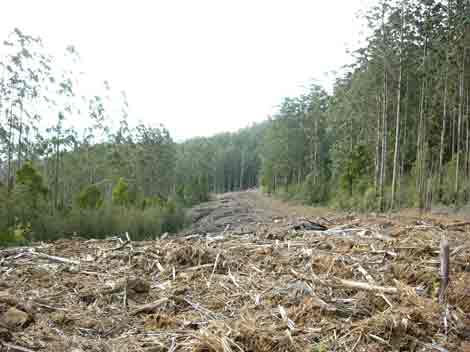
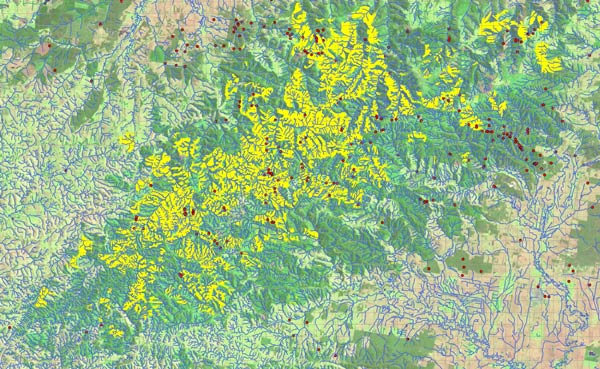
Extent of Strzelecki Ranges hardwood Reafforestion Schemes by Victorian Forests Commission and Australian Paper Manufacturers established between the 1960's and 1980's. Almost all of the yellow shading is Mountain Ash reforestation, reclassified in the 1980's as plantation. Mountain Ash is a known food tree of the Strzelecki Koala. Current management regimes allow for the logging of the Mountain Ash, with subsequent burning and herbicide application, followed by the replanting of Shining Gum, a non endemic species to the Strzeleckis and a non Koala food tree.
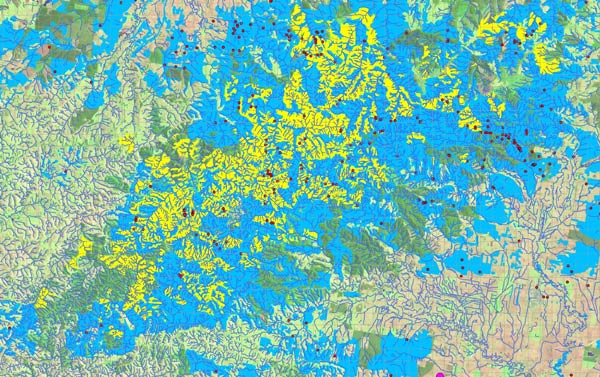
Blue indicates koala habitat with 2km additional range per koala siting. Yellow indicates amount of habitat loss associated with logging activities of Mountain Ash forests of Grand Ridge Plantations. Between 30-40% of the Koalas habitat in the Strzelecki Ranges will be logged in the next few years. Almost all of these logging coupes will be replanted with Shining Gum, a non-endemic koala food tree.
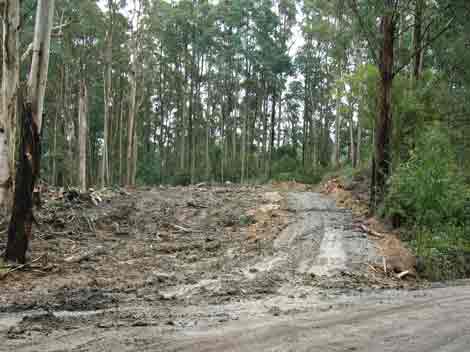
July 2005: Prime Koala habitat logged just off Budgeree Road, northern Strzeleckis.

June 2005: Koala in remnant Mountain Grey Gum on Budgeree Road, a known koala hotspot.
Sunday Age October 2, 2005 Super-koala habitat faces bulldozing by Claire Miller
Critical habitat supporting the so-called Strzelecki "super-koala" and endangered powerful owls is to be bulldozed as part of a controversial road-widening project in South Gippsland.
Several hundred trees, many home to koalas and with hollows suitable for nesting owls and other wildlife, will be lost, despite consultants warning the Latrobe City Council that the damp forest habitat is virtually irreplaceable in a region largely cleared of native vegetation.
The local member for Morwell, Brendan Jenkins, is appealing to Environment Minister John Thwaites for an 11th-hour reprieve after local conservationists lost their case in the Victorian Civil and Administrative Tribunal. Latrobe Council wants to widen Budgeree Road so that logging trucks servicing plantations can pass each other. Trucks now travel one way down the road and return via another route. Budgeree Road is also a tourist drive to Tarra Bulga National Park.
The tribunal initially raised strong objections to the project, near Boolarra, in the face of evidence that the council took little account of the vegetation affected, that traffic volumes did not justify the scale of the works, and that a redesign could save most of the trees. Then, in a surprise turnaround, it approved the project last month with minor amendments.
Strzelecki koalas are a genetically superior group that may hold the key to the species' long-term survival in Victoria. All other koalas in the state are descended from a handful of individuals transferred to French Island more than a century ago, a few years before koalas were hunted to near-extinction on the mainland. The French Island colony was used to repopulate the state, but inbreeding is now becoming apparent. The Strzelecki koalas, however, appear to be a remnant of the original and genetically diverse mainland population.
The roadside forest is rare in its own right, being of "very high conservation significance". This category has legislative protection under the Native Vegetation Management framework, and can be cleared only under exceptional circumstances. The loss of hollow-bearing trees is also listed as a threat under the Flora and Fauna Guarantee Act.
Consultants from Biosis Research told the Latrobe Council it would be difficult to find other damp forest areas that could offset the loss of roadside remnants.
Susie Zent, from Friends of Gippsland Bush, said VCAT had set conditions for the roadworks based on a mistaken classification by the Department of Sustainability and Environment as to the vegetation's significance. She said the VCAT decision could be set aside if the department admitted to an error of judgement and requested amendments to its permit conditions.
Latrobe's chief executive officer, Paul Buckley, said he expected VicRoads to sign off the final plans within three or four weeks. He said the additional width was needed to improve safety.
A spokesman for Mr Thwaites said the department was waiting for final details from the council, particularly in relation to offset measures. "Offset measures are required to ensure there is no overall loss of areas that have ecological significance," he said.
MELBOURNE OCTOBER 2, 2000 - Hancock Victorian Plantations (HVP) and the Australian Koala Foundation (AKF) announced a joint Memorandum of Understanding (MOU) and the beginning of field studies to learn more about koalas and their habitat on HVP's leasehold properties in the Strzelecki Ranges of Victoria.
In a joint announcment, Kevin White, chief executive officer of HVP, and Deborah Tabart, executive director of AKF, said the memorandum - which provides for an independent year-long review of koala population and habitat preferences - is expected to lead to a comprehensive forest management plan involving protection for the species in the Strzeleckis.
White and Tabart said the MOU provides a framework for obtaining scientifically credible data on koala populations, critical habitat and future habitat needs. The desired outcome is a management strategy to meet the long-term needs of the koalas in the region as well as the commercial interests of HVP's investors.
The MOU was signed by both parties earlier in the year after talks began last December. It is the first such agreement between the AKF and a timber operating company.
Field studies begin today led by AKF's head of conservation research, Mr John Callahan along with zookeepers from five major North American zoos: Toronto, San Francisco, Bergin, San Diego and Disney's Animal Kingdom. Dr Wayne Marion wildlife manager for Hancock Timber Resource Group, also will participate.
"The scientific community regards the Strzelecki koala population as making an important contribution to the national koala gene pool" Mr White said. "This MOU along with the field studies, will hopefully lead to a situation where critical koala habitat on HVP's holdings will be permanently protected."
Tabart said "This MOU and the final Koala Habitat Atlas that will be produced could lead the way to sustainable logging by all companies in the Strzelecki Ranges. The koalas in this region are critical to the future of Victorian koalas and we are delighted that HVP understands their scientific importance."
The Koala Habitat Atlas is a project that aims to rank, identify and map critical habitat in a given area. The project already has received a Computerworld Smithsonian Award of Innovative Use of Technology. "These maps will enable us to find the critical koala habitat on the property" said Tabart. "Until that is done, it is difficult to predict whether forest operations are affecting the koala population. We do acknowledge that HVP has effectively set aside large conservation areas in its policy not to log native forests. The maps will give certainty to HVP investors, the AKF and most importantly, the koalas" Tabart said.
Whilst HVP is owned jointly by US and Australian pension funds and infrastructure investors, the Melbourne-based company is overseen by the Hancock Timber Resource Group (HTRG), the world's leading timberland investment management organisation for institutional investors. HTRG is a wholly owned subsidiary of Boston-based John Hancock Financial Services, Inc. (NYSE:JHF)
AKF is a privately funded international organisation whose prime focus and aim is the long-term conservation and effective management of the wild koala in Australia. The organization has offices in Brisbane, New York, Washington and Tokyo.
For more information please contact:
Deborah Tabart. Executive Director, AKF dtabart@savethe
koala.com
Ann Sharp, General Manager, AKF (07) 3229 7233 (up to 29 Sept)
John Callaghan, Principal Ecologist, AKF who will be in the field (0419-778-601)
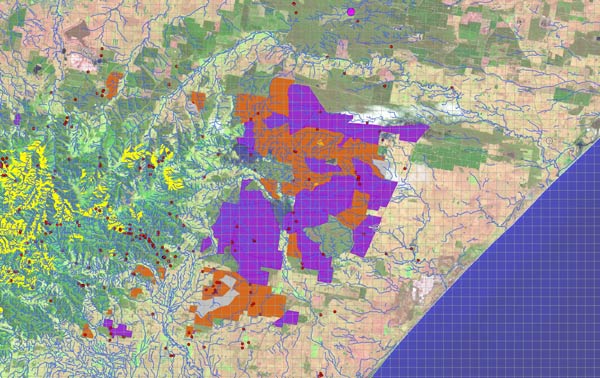
Land tenure and logging regimes of Mullundung and Wonwron State Forest. Most of the habitat loss in this forest is due to firewood cutting and burning by DSE. Logging coupes planned for 2004-6 are indicated in grey. Most of Mullungdung and Wonwron State Forests are protected under SMZ's etc, however this will not protect the forests from the impacts of fire burn-offs.
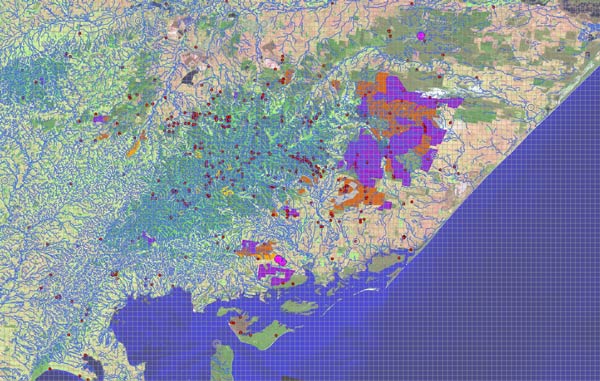
Extent of public land - (not including reserves) in the Strzelecki's bioregion.
After logging of reforestation areas in the Strzelecki Ranges, firewood cutting is probably the second largest contributor to habitat loss. Logging for firewood can take place in land zoned as General Management Zones. The largest of these areas includes forests in the Mullungdung and Wonwron areas east of the Strzelecki Ranges. No studies have been carried out on the impact of firewood cutting on the Strzelecki Ranges or Mullungdung and Wonwron State Forests. It would appear that prime koala food trees such as Yellow Stringybark (E. muelleriana) are being targeted by firewood cutters. The degradation of the regions's State Forests by firewood cutters and 'burn-off's will probably have a large impact on the future of the Strzelecki Koala.
DSE Policy
The Department of Sustainability and Environment (DSE) manages and licences a range commercial activities in Victoria's State forests. This currently includes timber harvesting in western Victoria, and the sale of minor forest produce, including domestic firewood, throughout the State.
To take firewood from a State Forest, you must obtain a licence from one of the DSE area offices. A royalty is charged according to the volume of wood removed. However there is also likely to be a thriving illegal market for firewood, both for personal consumption and commercial exploitation. From our observations in the Wonwron State Forest, it would appear that there are few controls on this activity. There is also no criteria established for commercial removal of trees that may be Strzelecki Koala habitat.
According to DSE; "The collection and removal of firewood from public land requires a licence from the Department of Sustainability and Environment (DSE), or a permit from a designated domestic firewood agency. Depending on the amount of firewood to be collected and the length of time over which it is to be collected, firewood is harvested under a Forest Produce Licence and Receipt, Firewood Permit, Forest Produce Licence or a Domestic Firewood Licence for Box Ironbark Community Firewood Supply Areas. The usual system for commercial operations is a Forest Produce Licence, where the royalty is paid monthly, based upon records of the previous month's cut. Forest Produce Licences are applicable for collections extending over longer periods and when 'significant' amounts of the product are to be harvested. (Forest Produce Licences in some Regions are only available via a tender process). For short-term and small volume commercial collection a Forest Produce Licence and Receipt is required. For personal collection a Forest Produce Licence and Receipt, Domestic Firewood Licence or Domestic Firewood Permit is required. For a Forest Produce Licence and Receipt, Domestic Firewood Licence and a Domestic Firewood Permit the royalty is paid in advance of collection. The maximum volume which may be purchased by a Forest Produce Licence and Receipt is 100 cubic metres per annum for commercial licensees and up to 20 cubic metres per annum for domestic licensees. (Maximum limits may vary, depending on the area of collection and are set by theRegions).
FIREWOOD COLLECTIONFOR PERSONAL USE
Firewood areas in State forests are available at various times throughout the year depending on timber harvesting activities in the area and seasonal conditions. Upon purchase of a licence you will be issued with:
· a map detailing the location of the firewood area(s); and
· a set of conditions.
Domestic cutters may collect firewood only from wood lying on the ground.
A chainsaw, bowsaw or is required to cross cut the fallen trees. Large diameter blocks should be split with a woodsplitter or axe.DSE endeavours to maintain both 2WD and 4WD access to firewood areas while they remain open.
The ability to park close to the firewood collection site, however, may be difficult and the use of a wheelbarrow to cart the firewood to the vehicle is recommended.
In some areas, collection of firewood is not permitted in winter, to reduce damage caused by vehiclesdriving on wet tracks. It is therefore recommended that you collect your firewood during summer then split and dry it so it is ready for the winter months, and that you use a wood merchant if you runout during winter in areas south of the Great Dividing Range.
Enforcement: Do not be tempted to take firewood for use at home from State forests without a licence or permit as heavy penalties apply.Regular patrols are carried out within State forests and DSE Officers may inspect firewood permits at any time. Penalties for unauthorised removal of firewood or falling of standing trees range from $100 for an on the spot fine, up to $5,000 and/or one year imprisonment.
Licences:Licences and advice on firewood collection can be obtained from the local DSE office near the area you wish to collect wood. The addresses and telephone numbers of DSE offices in Victoria that issue licences for firewood collection are listed at the end of this information. In many areas firewood permits are available from selected firewood agencies, which are usually retail outlets, such as general stores or petrol stations.Firewood removed from State forests for domestic use is usually sold by the cubic metre of stack.
The cost to November 2004 varies from $8.20/m³ to $24.50/m³ (including GST) depending on the area of collection. This comprises royalty of $8.20/m³ or $12.90/m³ (including GST) and, usually anextra charge of between $0.90/m³ to $10.70/m³ (including GST) to cover the costs of felling, cuttinginto lengths or additional access.A 1.8m x 1.2m trailer stacked 0.5m high is roughly 1 cubic metre of stack."
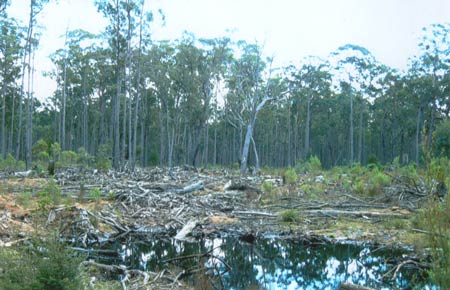
July 2005: Recent firewood cutting in General Management Zone - Won Wron State Forest. Numerous breaches to the Code of Forest Practices were identified in this Koala hotspot. It appeared that the firewood cutters were targeting Yellow Stringybark.
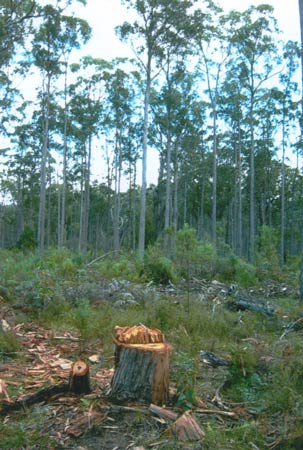
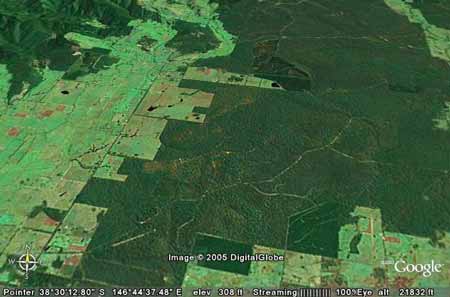
July 2005: Wonwron State Forest - Koala hotspot and firewood management zone.
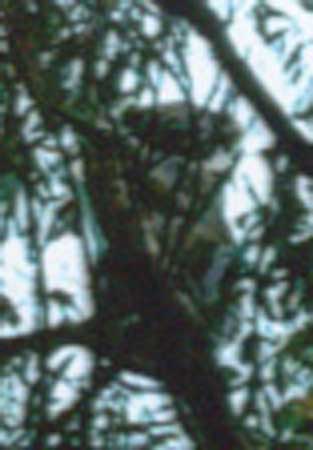
July 2005 Wonwron Koala
"On a national level, the Koala is not secure (Melzer, et al. 2000) and there exists a great deal of national and international concern for its conservation (Cork, et al. 2000). The level of international concern is reflected in the decision in May 2000 by the U.S. Fish and Wildlife Service to list the Koala as a threatened species under the U.S. Endangered Species Act. This decision was based largely on documented rates of vegetation clearance within the Koala's distribution.
However, in an assessment conducted in 1995 on behalf of the Australian Government, the Koala was assessed as not meeting the criteria for listing as a threatened species at the national level (Maxwell, et al. 1996). In Victoria, the Koala has not been listed as threatened under the Flora and Fauna Guarantee Act. In New South Wales it is listed as Vulnerable, as is the population in South-east Queensland". p 4 Victoria's Koala Management Strategy DSE 2004.
"Responsibility for native fauna in Victoria is vested in the Crown under the provisions of the Wildlife Act 1975. This Act confers protection on all vertebrate animals (except fish) that are indigenous to Australia. Strategic responsibility for management of Koalas in Victoria rests with the Biodiversity and Natural Resources Division of the Department of Sustainability and Environment and extends across all public and private land. This strategic responsibility includes the definition, authorisation and coordination of appropriate Koala management practices. Responsibility for on-ground action rests with the relevant land manager, within the bounds of legislative provisions, this strategy and associated guidelines". p 5 Victoria's Koala Management Strategy DSE 2004.
Other relevent acts include; Wildlife Act 1975, National Parks act 1975, Forests Act 1958, Sustainable Forests (Timber) Act 2004, Planning and Environment Act 1987*, Prevention of Cruelty to Animals Act 1986 and Victoria's Biodiversity Strategy.
*In terms of the Strzelecki Koala, local government is a major player in the survival of this animal, as most of the land regarded as Strzelecki Koala habitat is for all intents and purposes now classed as private land.
According to Victoria's Koala Management Strategy p5 "Local Government planning schemes play a key role in land-use planning and zoning, and thus strongly influence the capacity to maintain Koala habitat on freehold land and other land within the jurisdiction of Local Government". Victoria's Koala Management Strategy DSE 2004.
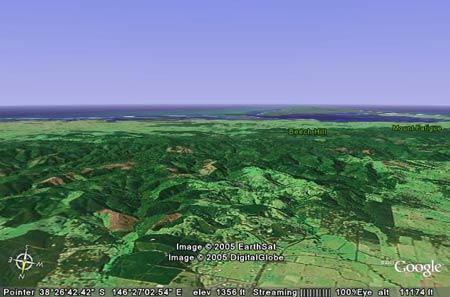
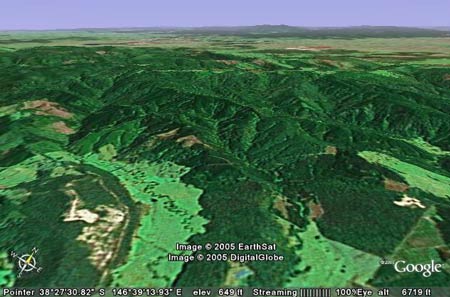
Strzelecki Ranges south face - Macks Creek Catchment. Strzelecki Koala hotspot.

South Gippsland looking east above Foster, showing the extent of land clearance. Foster is a South Gippsland Koala hotspot.
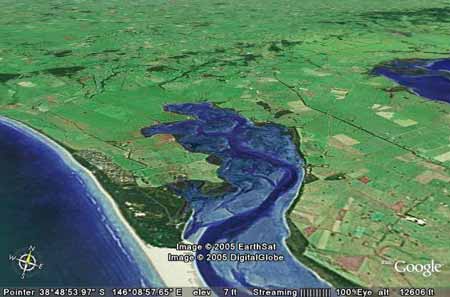
Sandy Point/Waratah Bay. South Gippsland Koalas also found here.

Western Strzeleckis, a few Koalas are also found here.
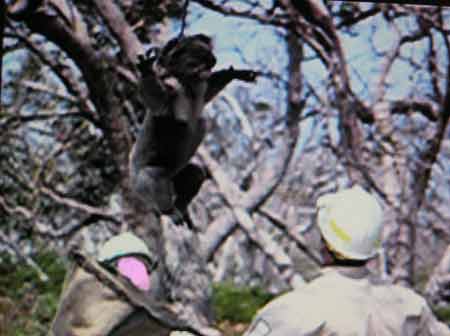
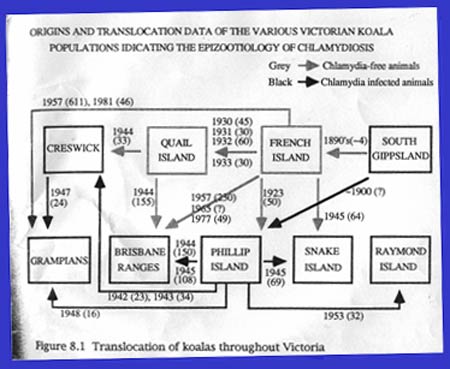
". . .Fortunately, small numbers of Koalas were introduced by local people to French and Phillip Islands during the 1890's. In fact, the French Island population had overbrowsed preferred food trees to cause concern by the early 1920's. So, in 1923, the Department of Fisheries and Game began an active translocation program to other sites to prevent starvation of Koalas and overbrowsing as part of a threatened species management program. . . Early in the translocation program islands were selected as release sites as they were relatively safer from wildfire and undue human disturbance." ANHM Presentation: Managing Victoria's Koalas by Peter Menkhorst.
Introduction and Relocating* of Koalas on Victorian Islands
(Data sourced from: ANHM Presentation: Managing Victoria's Koalas by Peter Menkhorst).
Phillip Island - introduced in 1923. Removal of 880 in 1957.
Kangaroo Island (South Australia) - introduced in 1923 and 1925.
Quail Island - introduced from 1930 to 1933, inclusive and 1947. Removal of 1355 in 1944.
Chinaman Island - introduced in 1930, 1931 and 1957.
Snake Island - introduced in 1945.
Wartook Island - introduced in 1953
Raymond Island -42 introduced in 1953.
French Island - removal of 1483 in 1957.
*It should also be noted that there have been substantial unofficial translocations that have not been recorded by the Government over the years.
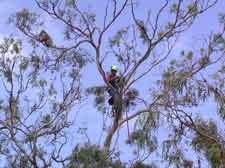 |
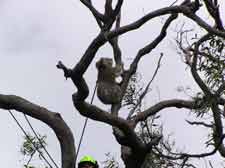 |
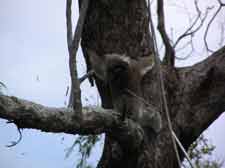 |
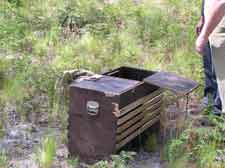 |
 |
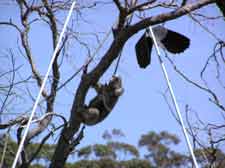 |
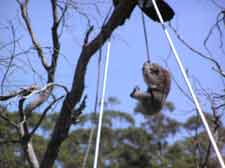 |
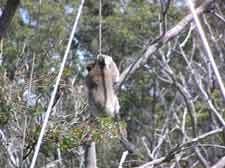 |
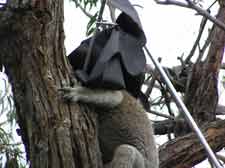 |
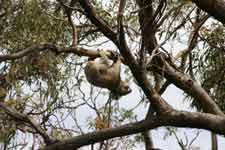 |
 |
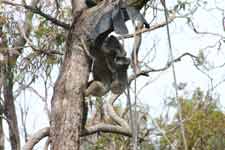 |
Above images: November 2004 - Koala translocations on Raymond Island conducted by the Victorian State Government. The koalas were moved to a site north of Bairnsdale. Koalas are noosed and hanging from branches in common. The trauma of being noosed, boxed and left in the hot sun leaves alot to be desired.
"Island populations began with only a small subset of the genetic variation that was present in Victorian Koalas in the 1890s. Each time Koalas were captured for relocation, this small subsample of genetic variation was further sub-sampled. As the translocation program has been so widespread, any remnant populations of Koalas have probably had their original gene pool swamped by the restricted gene pool of the island animals. Recent studies of variation in mt DNA across the Koala's range has supported this scenario. The same haplotype is present in most Victorian and Kangaroo Island populations. South Gippsland and Strzelecki Range Koalas have two extre haplotypes - one shared (H7) and a unique third haplotype each. The Strzelecki and South Gippsland populations thus form a seperate management unit within Victoria and have been treated this way since 1989". ANHM Presentation: Managing Victoria's Koalas by Peter Menkhorst.
Alternatives to Translocation
Translocation had effectively restored Koalas to most of the remnant habitats in Victoria. It cannot be a viable option of the control of Koalas for much longer. Alternative strategies are to use population control methods. Two methods have been selected for field trails, viz (i) Hormonal implants to female Koalas, (ii) Vasectomy of male Koalas. These are being tried by Ecoplan Pty Ltd (Dr D. Middleton).
i) hormonal impants
Two hormones have been tried in the field on a wild population
(a) A progestin "Levonargestrel" (commercial form) is an approved human contraceptive in parts of Europe. A single implant of 70 mg of Levanorgestrel in a sylastic tube 40mm x 2.3mm.
(b) A low dose of oestradiol - 2 dose ration 200 to 300ng/kg/day and 100-150 ng/kg/day of powdered Oestradiol 17 beta in 14mm x 4.3 mm sylastic tube."
ii) vasectomy of males on French Island ANHM Presentation: Managing Victoria's Koalas by Peter Menkhorst.
According to DSE records the following translocations of koalas occurred near the Strzelecki region prior to 1990;
1952: 6 koalas sourced from Chinaman Island, released at Glen Chromie Park near Warragul (38 10 Lat 145 56 Long).
1965: Unknown number of French Island Koalas released at Moondarra (38 05 Lat 146 23 Long).
1977: 28 Phillip Island Koalas released near Inverloch (38 38 Lat 145 44 Long).
1986: 24 French Island Koalas released near Holey Plains (38 13 Lat 146 55 Long).
1986: 12 Sandy Point Koalas released near Gellions Run (38 40 Lat 146 35 Long).
Between 1923-89 a total of 10,731 koalas were released into the wild, with more than 70 (0.65%) released in the Strzelecki Study area. (From our research we were only to find one other translocation near Gellions Run after 1990. There have however been reports of unofficial releases). Source: p292-7 Emmins, John Jeffrey (The Victorian Koala (manuscript): Genetic Heterogeneity, Immune Responsiveness & Epizootiology of Chlarydiosis 1996 Thesis (PhD)-Monash University.
However it is unknown whether these translocated koalas have interbred with the Strzelecki/South Gippsland koalas, thereby possibly compromising their genetic inheritance.
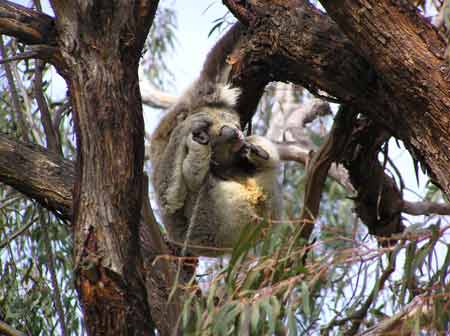
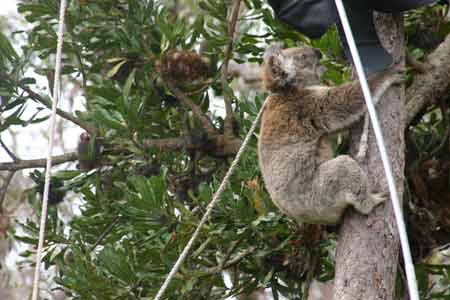
November 2004: Victorian Government koala translocations Raymond Island
A natural population control mechanism?
"Diseases afflicting wild koala populations are relatively well known (Canfield 1990a, 1990b), especially those associated with the bacterium Chlamydia. Once perceived as a threat to their survival (Brown and Carrick 1985; Brown et al. 1987), chlamydiosis is now generally accpeted as a normal component of the species' natural history (Martin and Handasyde 1990a: Phillips 1997).
Two species, Chlamydia pneumoniae and C. pecorum, are involved (Glassick et al. 1996; Sherwin et al), and the latter is also associated with sheep and cattle, which raises the possibility of cross-species transmission (Jackson et al. 1997) . . . There is a strong association between the majority of those populations in South Australia and Victoria that suffer from over-browsing or overabundance and the absence of Chlamydia (Emmins 1996b; Phillips 1997). This phenomenon can be readily traced to the founder population on French Island, Victoria which was established in the 1880s from as few as two or three individuals (Houlden et al 1996) and is Chlamydia-negative (McColl et al. 1984; Emmins 1996a). This suggests that Chlamydia negativity is a direct consequence of having derived from that population. If so, then the problems of populations founded from French Island stock are not independent of one another but share a common attribute, notably the absence of Chlamydia. It has been argued that the absence of Chlamydia in these populations means that they are incapable of regulation in response to a limiting food resource (Phillips 1997)." Stephen S. Phillips - Population Trends and the Koala Conservation Debate - AKF 2000.
"After developing the ELISA and testing over 1000 koala sera from all over their range, it was evident that chlamydiosis was widespread and endemic in all wild koala populations other than French Island (Vic), or their direct descendants such as Kangaroo Island (S.A.). The Raymond Island studies confirmed that koala chlamydiosis, predominantly a sexually transmitted disease, was causing infertility in some females. Once infected the koala (male or female) is unable to eliminate the infection. They then maintain high antibody titres and a carrier status for the remainder of their lives. For males the Chlamydia causes a relatively mild, usually asymptomatic infection but in females can cause urethritis, pyometritis and cystitis. The damage caused by such an infection can be very debilitating for the koala and render it infertile and can even cause death..." Source: p288 Emmins, John Jeffrey (The Victorian Koala (manuscript): Genetic Heterogeneity, Immune Responsiveness & Epizootiology of Chlarydiosis 1996 Thesis (PhD)-Monash University
"Eye disease no danger to koala numbers - expert The Sun 4/12/85
Australia's koala's are not in danger of extinction, despite a disease which causes blindness and infertility in females, an expert said yesterday. Monash University zoologist Mr Roger Martin said although the problem was widespread in some communities, many koala populations were not affected. "To say koalas are threatened by extinction simply is not borne out by the facts at this stage," he said.
The disease - caused by a virus-like bacteria called chlamydia - infected the koala's reproductive tract and was associated with a trachoma-like eye disease called pink-eye. "It is severe in some populations such as Phillip Island where more than 85 per cent are infertile because of infection with the disease," Mr Martin said. "But other populations such as that on French Island, Kangaroo Island and at Sandy Point on Western Point virtually are disease-free."
Mr Martin said because the infection was not passed on from mothers to offspring it would be simple to create a disease free population. The Phillip Island population had been declining for the past six years and there were now less than 200 animals on the island. But there were other infected populations where koalas were still breeding at a level which would sustain their numbers. Koalas were more widespread in Victoria than in NSW or Queensland but the disease was most severe in warmer climates."
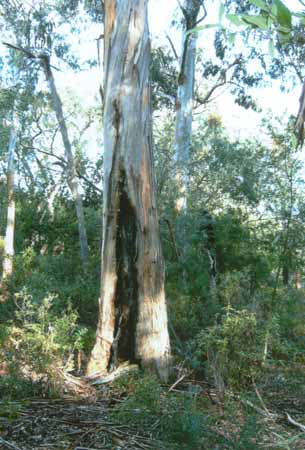
(excluding cultivated plants. Taxonomy and nomenclature follow Walsh and Entwisle (1996); it is assumed that all subspecies and variants of a species are eaten. (Source: Victoria's Koala Management Strategy - Department Sustainability and Environment 2004)
* Preferred forage species in Victoria. Strzelecki Species, Central Gippsland Species.
|
Scientific Name
|
Common Name
|
|
Eucalyptus baxteri
|
Brown Stringybark
|
|
Eucalyptus bosistoana
|
Coast Grey-box
|
|
Eucalyptus botryoides
|
Southern Mahogany
|
|
Eucalyptus bridgesiana
|
But But
|
|
Eucalyptus camaldulensis*
|
River Red-gum
|
|
Eucalyptus camphora
|
Mountain Swamp-gum
|
|
Eucalyptus cephalocarpa
|
Mealy Stringybark
|
|
Eucalyptus cypellocarpa
|
Mountain Grey-gum
|
|
Eucalyptus dives
|
Broad-leaved Peppermint
|
|
Eucalyptus globulus*
|
Southern Blue-gum
|
|
Eucalyptus goniocalyx
|
Bundy
|
|
Eucalyptus largiflorens
|
Black Box
|
|
Eucalyptus leucoxylon
|
Yellow Gum
|
|
Eucalyptus macrorhyncha
|
Red Stringybark
|
|
Eucalyptus melliodora
|
Yellow Box
|
|
Eucalyptus microcarpa
|
Grey Box
|
|
Eucalyptus muelleriana
|
Yellow Stringybark
|
|
Eucalyptus obliqua
|
Messmate Stringybark
|
|
Eucalyptus ovata*
|
Swamp Gum
|
|
Eucalyptus pauciflora
|
Snow Gum
|
|
Eucalyptus polyanthemos
|
Red Box
|
|
Eucalyptus radiata
|
Narrow-leaved Peppermint
|
|
Eucalyptus regnans
|
Mountain Ash
|
|
Eucalyptus rubida
|
Candlebark
|
|
Eucalyptus tereticornis
|
Gippsland Red-gum
|
|
Eucalyptus viminalis*
|
Manna Gum
|
Koalas eat gum leaves - exclusively (maybe also a few tiny fragments of stem) - to obtain nourishment, but once in a while, for other reasons, they will also eat a bit of soil.
The majority of chosen food trees appear to be those with essentially smooth bark, and these also have a high natural leaf-oil content. In Victoria, the best known Koala food tree is the Manna Gum, E.viminalis. This tree species comes in at least two natural forms or morphs - the tall graceful gums of the Victorian highlands and river valleys, and the rather scrubbier, more stunted variety that grows along the coastal plain and heathlands. The trees on Phillip and French Islands are of this latter growth appearance.
At certain times of the year, particularly in Spring, when the very new growth is appearing, the plant itself manufacturs prussic acid, a very potent poison ("bitter almonds" smell) and so the Koala is unable to eat the leaf tips. If no alternative food is offered, the Koala will starve rather than eat. Perhaps the acid prevents creatures damaging the new plant growth?
Digestion of the large amount of leaves and the oils contained, plus the cellulose of which much of the solid part of each leaf is composed, requires a rather specialised digestive system. Koala's digestive tract is the same as in many other marsupials, with the exception of a gastro-cardiac gland in the stomach and an appendix (caecum) of the order of almost 3 metres long. Within this is the digestion of the oily mass of leaves.
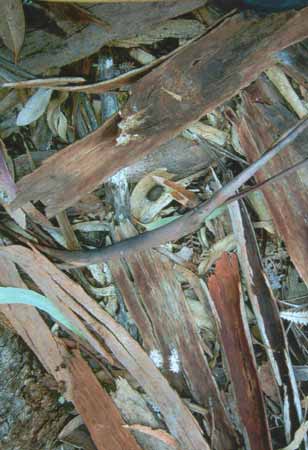
Koala scat under Mountain Grey Gum in Macks Creek Catchment. Scats are a useful way of determining tree preferences for free ranging Koalas, however scats do not provide details of habitat use.
Koalas have been found to eat species other than Eucalypts and location of tree species also can be determined by local geology. "...The results established that grey gum (Eucalyptus punctata) and blue-leaved stringybark (E.agglomerata) were most preferred by koalas in the study area, but only when growing on shale-based substrates. The preferential utilisation of E.punctata and E. agglomerata on substrates derived from shales, compared with that recorded for the same species on sandstones, suggests that their use by koalas was influenced by differences in nutrient status between substrates..." (Tree species of koalas (Phascolarctos cinereus) in the Campbelltown area south-west of Sydney, New South Wales - Stephen Phillips & John Callaghan 2000).
"...While some of these accounts portray koalas as opportunistic browsers, as a general rule only some Eucalyptus species will be preferentially utilised in a given area while others, including some non-eucalypts, appear to be utilised opportunistically for feeding or other purposes (Lee and Martin 1988; Hindell and Lee 1990; Phillips 1990), or because they occur in close proximity to preferred food tree species (Phillips et al. 2000). Soil nutrient levels are also considered to influence the palatability of some tree species for koalas (Cork and Braithwaite 1996)." (Tree species of koalas (Phascolarctos cinereus) in the Campbelltown area south-west of Sydney, New South Wales - Stephen Phillips & John Callaghan 2000).
"...In total, 2499 trees, comprising 1159 eucalypts and 1340 non-eucalypts from 45 field plots, were assessed. Evidence of tree use, specifically the presence of koala faecal pellets, was observed in 20 of the 45 field plots, with faecal pellets recorded from beneath 7 Eucalyptus species and 6 species of non-eucalypt.
... Faecal pellets were recorded beneath six species of non-eucalyptus. Analysis was restricted to five species: Angophora costata, Banksia serrata, Corymbia gummifera, Melaleuca hypericifolia and Syncarpia glomulifera..."(Tree species of koalas (Phascolarctos cinereus) in the Campbelltown area south-west of Sydney, New South Wales - Stephen Phillips & John Callaghan 2000).
"In areas such as Campbelltown where consequences of the resource-availability hypothesis appear to be evident, it could be implied that habitat quality from the koala's perspective will be more complex than simply a measure of the relative abundance of preferred food tree species. Indeed, in assuming some variabilty in the availability of nutrients throuhgout an otherwise homogeneous substrate, one might also suspect a corresponding degree of intraspecific variation in the palatability of key food tree species..."(Tree species of koalas (Phascolarctos cinereus) in the Campbelltown area south-west of Sydney, New South Wales - Stephen Phillips & John Callaghan 2000).
"Using a plot based methodology, 3847 trees were sampled, comprising 15 Eucalyptus species and 17 species of non-eucalypt. Evidence of tree use by koalas, specifically the presence of koala faecal pellets, was recorded from beneath 10 Eucalyptus species and 9 species of non-eucalypt. . . " The tree species preferences of koalas (Phascolarctos cinereus) inhabiting forest and woodland communities on Quaternary deposits in the Port Stephens area, New South Wales - Stephen Phillips, John Callaghan and Valerie Thompson.
". . . Cork et al. (1990) considered that the key to mapping koala habitat was a consideration of tree communities rather than individual tree species. However, as the results of this work and the above studies suggest, individual tree species, where they can be shown to be subject of preferential use by koalas, are a critical consideration in terms of understanding carrying capacity. Moreover, we would suggest that an understanding of which tree species are important and which are not clearly increases the likelihood of finding koalas or evidence thereof, while also permitting the relative worth of the vegetation communities being utilised by koalas to be ascertained with a greater degree of confidence than that which is currently being practised" The tree species preferences of koalas (Phascolarctos cinereus) inhabiting forest and woodland communities on Quaternary deposits in the Port Stephens area, New South Wales - Stephen Phillips, John Callaghan and Valerie Thompson.
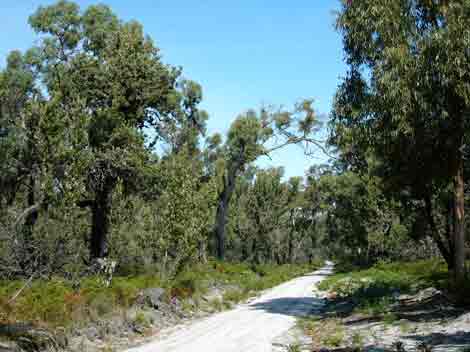
April 2004: Regenerating - post fire - Yertchuk and Banskia forest near Tom's Cap in Mullungdung State Forest.
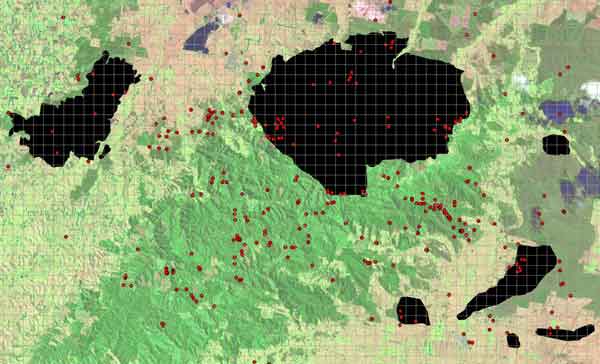
February 2009: Approximate locations of February 2009 bushfires which destroyed a large portion of the known koala habitat. Hundreds of koalas were reported as being killed in the Jeeralangs alone, including known breeding colonies.
"The immediate and short-term impacts of fire on fauna populations are related to mortality during the fire, loss of shelter and nesting habitat, increased predation and decreased prey availability. Longer-term effects involve changes to vegetation characteristics. Inappropriate burning regimes, such as too frequent or too infrequent burning, can alter vegetation floristics and structure, and may affect habitat suitability for some fauna."p61 Proposed Forest Management Plan for Gippsland NRE 2001
Due to the outcry after the 2003 Alpine bushfires, there has been massive pressure on the government to increase both the scale of burns undertaken by DSE and the frequency of such fires. It is the contention of Friends of the Earth that current burning practices are likely to put biodiversity at risk, and that future burning practices need to be based on improved dialogue between researchers and land managers as well as genuine consultation with community members. There is no conclusive proof that pre-emptive burning maintains, protects or enhances biodiversity. In fact, too frequent burning may increase the flammability of some ecosystems. There is also no conclusive proof that pre-emptive burning is beneficial to the Strzelecki Koala and it is highly probable that unless Koala surveys are carried out prior to pre-emptive burning Koalas could be killed by such burns, especially if the pre-scribed burns escape boundary lines.
Prescribed fire and fauna management do not necessarily apply to the Strzelecki/South Gippsland Koala, due primarily to the fact that the species is not considered threatened under State Laws including the Flora and Fauna Guarantee Act. Species that do come under prescribed fire and fauna management in the Gippsland Region include; New Holland Mouse, Smoky Mouse, Spotted Tree Frog, Grey-headed Flying-fox, Yellow-bellied Sheathtailbat, Square-tailed Kite, White-bellied Sea-eagle, Alpine Bog Skink, Alpine Water Skink, Glossy Grass Skink, Sooty Owl, Powerful Owl, Masked Owl.
However, the Flora and Fauna Guarantee act does not apply to private land, as it much of the land inhabited by the Strzelecki Koala. Therefore there are no Government safeguards regarding the Strzelecki Koala and pre-scribed burns.
The FFG Act lists two Threatening Processes that concern prescribed burning;
1) "High frequency fire resulting in disruption of life cycle processes in plants and animals and loss of vegetation structure and composition"
2) "Inappropriate fire regimes causing disruption to sustainable ecosystem processes and resultant loss of biodiversity".
In November 1997, the Victorian Government introduced legislation requiring forest plantation companies to form fire brigades when their plantation assets reached a critical size. These industry-based fire brigades are operated by the plantation company but are under the operational control of CFA. Industry brigades are only required to service the companies' plantation assets for wildfire response and fire management planning. However if the parent plantation company desires, the brigade is empowered to operate outside their designated area. See Here for More Information
"Fire is a direct threat to koalas and can alter the vegetation composition. Very hot fires that extend into the canopy (crown fires) threaten the animals. Unsuitable fire regimes can deplete some plant species and favour others that are highly flammable and contribute to the fuel load" Draft Nature Conservation (Koala) Conservation Plan 2005.
"Gippsland has suffered from bushires numerous times in the past 150 years. Major wildfires in the South Gippsland/Strzelecki region occurred in 1898, 1905?, 1906?, 1912?, 1926?, 1932?, 1939, 1942 and 1965. The 1898 fires burnt 260,000 hectares in South Gippsland, destroying more than 2000 buildings.
"The twenty year average (1980/81 to 1999/2000) for the total number of wildfires on or near public land in the planning areas is 68. Over 75% of these were between 0.1 to 5.0 ha in size. The average total area burnt per annum is 6370 ha . . . For the same period, over 40% of all fires were ignited by lightning strikes. The next most significant source of wildfires is deliberate lights (ie by humans) causing 19% (NRE 1999a)." p59 Proposed Forest Management Plan for Gippsland NRE 2001
"Fire management on public land in Victoria is governed by the Forests Act 1958, National Parks Act 1975 and the Code of Practice for Fire Management on Public Land (CNR 1995b) (the Fire Code)...
The Forest Act requires NRE to 'carry out proper and sufficient work for the prevention and suppression of fire in every State Forest, National Park and all protected public land..."p59 Proposed Forest Management Plan for Gippsland NRE 2001
"A key element of Fire Protection Plans is a zoning system (referred to as Fuel Management Zones) for the use of planned fire. The system aims to help protect life, property and public assets, as well as to meet specific ecological requirements. The zones provide for a range of fuel management responses according to the level of protection required, the maximum overall fuel hazard recommended (as described by Wilson (1993) and McCarthy et al. (1998), and the fire regime that is required to maintain biota and minimise fuel hazard levels.
The fuel management zones are described in the Fire Code (CNR 1995b) and are identified in the Gippsland Fire Protection Plan (NRE 1999a)... Details of the timing and location of fire protection works (eg fuel reduction burning) and services program are covered in a three-year Fire Operations Plan... p60 Proposed Forest Management Plan for Gippsland NRE 2001
"The five fuel management zones are as follows.
*Fuel Management Zone 1 Asset protection: to provide the highest level of strategic protection to human life, property and highly valued public land assets and values. This zone will generally occupy only a small proportion of public land.
*Fuel Management Zone 2 Strategic fuel-reduced corridors: to provide strategic corridors of sufficient width and continuity to provide a substantial barrier to the spread of wildfire, to minimise the damage caused by wildfire and provide areas to assist in safe and efficient fire suppression.
*Fuel Management Zone 3 Broad area fuel reduced mosaic: to provide an irregular mosaic of areas of fuel reduction which will complement works in Zones 1 and 2 in reducing severity of wildfire, and are consistent with broad-based ecological management objectives.
*Fuel Management Zones 4 Specific flora and fauna management: to provide for the use of planned fire for active management of specific flora and/or fauna, and vegetation communities which have critical fire regime requirements not adequately catered for by the broadly defined fuel and ecological management objectives.
*Fuel Management Zone 5 Exclusion of prescribed burning: to provide for the exclusion of planned fire for at least the period of the Fire Protection Plan of vegetation in which there would be high potential for economic, ecological or cultural loss if it was subjected to planned fire. These areas may be subject to special protection measures to reduce the probability of damage by wildfire. (Please note that under the Review of Code of Practice for Fire Management on Public Land it is proposed to remove Fire Management Zone 5. Given that there is already limited understanding of the impacts of prescribed burning on the Strzelecki Koala, it would not be beyond the realm of possibility that we could see a vast reduction in koala numbers in sensitive areas that come under the definition of prescribed burns).
The area of each fuel management zone (NRE 1999a) in the planning area is approximately 60 000 ha Fuel Management Zone 1, 221 000 ha Zone 2, 476 000 ha Zone 3, 301 000 ha Zone 4 and 272 000 ha Fuel Management Zone 5." p60-61 Proposed Forest Management Plan for Gippsland NRE 2001
Prescribed fire within Forest Management Zones
Where a Special Protection Zone (SPZ) is located in Fuel Management Zones 1 and 2, the values within the SPZ which may be affected by fuel reduction burning will be considered in the development of Fire Operations Plans. Wherever possible, fuel reduction burning programs that maintain SPZ values, but do not compromise the objectives of the fuel management zone, will be preferred". p65 Proposed Forest Management Plan for Gippsland NRE 2001
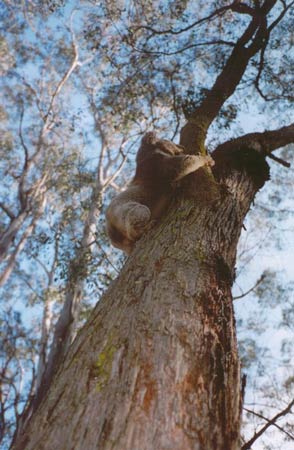
"... The early Aboriginies had many names for it, including koala, kolo, kurboroo, koolewong and koobor the drought-maker.
The word 'koala' comes from the language of the Katang people who originally lived in the area north of Sydney. It does not mean 'don't drink' or 'no-water' - the Katang words for these phrases are bidjagi giwi, and badu giwi, respectively. The work koala, in the Katang language probably has no meaning other than the animal itself. The name 'kurboroo' however, means 'does not drink' and comes from a different Aboriginal language. The Aboriginal myth about the koala which I find most fascinating is that concerning Koobor the drought-maker. The legend comes from south-eastern Australia.
Koobor was an orphan whose relatives neglected him and treated him badly. He ate gum leaves but was never given enough water. One day his relatives went food gathering and forgot to hide the drinking water, so for once Koobor had enough to drink. He then hung all the water-buckets in a tree and, climbing into the tree himself, he sang a magic song that caused the tree to grow so fast that it became the tallest tree in the forest. When his relatives returned they demanded that Koobor should return the water, but he refused. Eventually two medicinemen climbed the tree, thrashed Koobor, and threw him to the ground. As the people watched, Koobor's body changed into a koala and climbed into a tree, where he no longer needs water to stay alive". Source: Habitat, Vol 1, No. 2, Sept 1973 Koalas thrive in tropic haven by Robert Degabriele
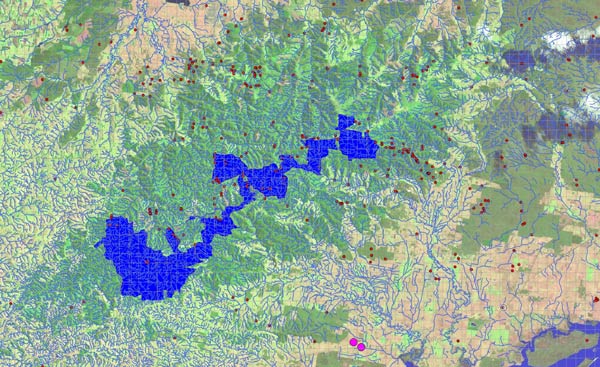
Strzelecki Cores and Link Reserve in relation to Koala sitings since 1990. Most koala sitings lie outside of this reserve.
Development of a Memorandum of Understanding
In October 2004, Hancock Victorian Plantations (HVP), the Nature Conservancy and Trust for Nature, committed to an historic MoU, with the aim of creating a new reserve in the Strzelecki Ranges, located in an area between the National Estate forests of Gunyah Gunyah to just past Tarra Bulga National Park, a distance of approximately 25km.
The new reserve would;
*cover an area of approximately 9000 hectares
*Include the cool temperate rainforests and headwater forests of the Agnes River, Franklin River, Albert River, Little Albert River, College Creek, Jack River, South Middle Creek, Tarra River and Merrimans Creek.
The proposed reserve contains cool temperate rainforest that have a direct link back to the ancient forests of Gondwanaland. These forests have survived for 60 million years!
The reserve protects most of the cool temperate rainforest attributes of the Strzeleckis and was not designed to protect core koala attributes.
Flora and Fauna species in this forest include;
Powerful Owl, Strzelecki Koala, Strzelecki Burrowing Crayfish, Tiger Quoll, Greater Gliders, Yellow Bellied Gliders, Mountain Bobuck, Sooty Owl, Slender Tree Ferns, Skirted Tree Ferns, rare rainforest ferns and several as yet undescribed species of invertebrates.
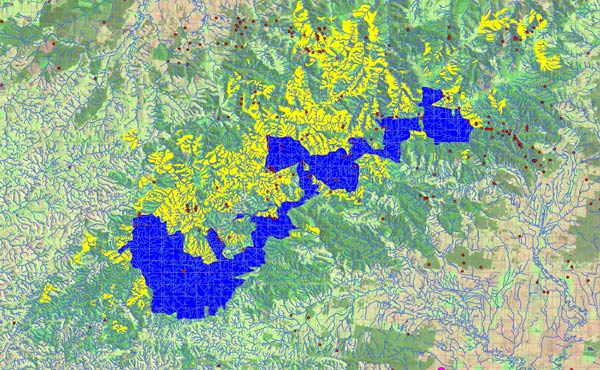
Strzelecki Cores and Links Reserve in relation to reforestation. yellow is mt ash to be logged, dark blue is cores and links - red dots are koala sitings.
During the 1960's through to the 1980's, the Victorian Forest Commission and Australian Paper Manufacturers replanted thousands of hectares of forest in the Strzeleckis, including approximately 2500 hectares of Eucalypt Regnans forest which now forms part of the proposed 9000 hectare reserve.
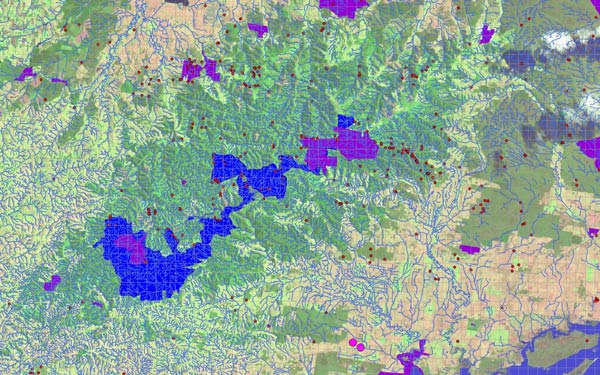
Strzelecki Cores and Links in relation to existing Reserves in the Strzeleckis.

The Strzelecki Ranges have in the past generated little interest from established state and national based conservation groups. Local groups have been vigilant, but not networked on a state or national basis to have the necessary clout to bring about fundamental change in attitude that the Strzelecki's are simply a plantation resource. The Strzelecki reforestation projects have long been seen by industry, government and conservation groups alike as the major source of hardwood timber for the Maryvale pulp mill.
The logic from conservation groups like Environment Victoria and Wilderness Society went something like; "It's better to log the Strzeleckis than the native forests of the Central Highlands and East Gippsland". Effectively the Strzelecki's was traded off for the 'more important' forests elsewhere in Victoria. This philosophy has been fundamentally flawed and certainly has not factored in the environmental attributes of the Strzelecki Ranges such as the Strzelecki Koala and Cool Temperate Rainforest. Effectively the Strzeleckis became a Industrial Sacrifice Zone which could be logged forever in increasingly short rotations.
With the arrival of independent forest certification schemes such as Forest Stewardship Council (FSC) in 2002, conservation groups Friends of the Earth and local group Friends of Gippsland Bush, decided that it would be better to have logging audited by third party certifiers, rather than leaving the logging entirely to the company. Both groups realised the enourmity of their task and both groups realised that they would gain little support for their stance, due to lack of interest by the wider conservation movement who had effectively sold the Strzelecki's out in the late eighties and mid nineties by agreeing to the Strzelecki's myth that the Strzeleckis was essentially only a plantation resource. FoE and FoGB were also not supported by the Victorian Government who had effectively privatised most of the Strzelecki's with the Victorian Plantations Corporation Act 1993.
The Australian Plantations report commissioned by Environment Victoria in 1995 and written by the economist Judy Clark did not make for pleasant reading for groups fighting for the Strzeleckis. Not only were all of the public and private Strzelecki reforestation projects classified in the report as plantations, but industry sources were quoted verbatim and their estimations of MAI (Mean Annual Increment) were used to predict unrealistic Strzelecki woodchip volumes. Almost every environmental group in Australia and Victoria supported the conclusions of the report, which essentially allowed for massive clearfelling of the Strzelecki forests established through reforestation schemes at unsustainable rates. The goal of the report was to 'prove' that shutting down logging in native forests was possible, as alternatives could be sourced from existing plantations.
Instead of being cautious in their recommendations, the report gave industry a green light to again clearfell the Strzeleckis. This in turn made it extremely difficult to claw back areas of the Strzeleckis that were in dispute, due to the perception that the environment movement was happy to support plantation logging. FoE and FoGB have not supported an entire shut down of logging in the Strzeleckis, but neither have the acquiesed to industry's wishes in the region.

April 2005: Hardwood 'plantation?' logging by Grand Ridge Plantations at Ryton Junction in very close proximity to Cool Temperate Rainforest at a site of State Botanical Significance. Misclassification of eucalypt forest as eucalypt plantation has led to major problems in the Strzelecki Ranges. Green groups must take some responsibility for this misclassification.
Extracts from;
Australia's Plantations - A Report to the State Conservation Councils by Judy Clark - Environment Victoria 1995.
p172 "Eucalypt plantation processing.
The major processing opportunities for Victoria's eucalypt plantations are concentrated in the Latrobe region with 18 000 hectares of eucalypt plantations currently established by Amcor and the Victorian Government. In addition, about 450 hectares of eucalypt plantations have been established by farmers at at 1992 (Angus Pollock per comm.).
Total areas of eucalypt plantations established up to 1995 included 10 098 Amcor plantings and 7151 hectares Victorian Plantations Corporation.
... p173 AMCOR PLANTATIONS
Amcor's plantings established prior to 1985 are predominantly E. regnans with E.globulus accounting for most of the plantings since. The MAI for Amcor's E. regnans plantings is considered to by 19, managed over rotations of 30 years. Shorter rotations of 20 years with a MAI of 22.5 is expected for the E.globulus plantings (Angus Pollock pers. comm.). All plantations are currently managed for chiplog production. Currently there is a stock of 350 000 m3 (not per annum) of chiplogs in Amcor plantations greater than 30 years of age (Angus Pollock pers. comm.,.) Projected wood yields are presented in Table B9.
PUBLIC PLANTATIONS
The VPC is currently determining production strategies for the 7000 hectares of public eucalypt plantations in the Latrobe Region . . . However, survey work, undertaken by the CSIRO, on plantation sawlogs indicates that the potential for further processing into appearance grade sawntimber is virtually non-existent. . . Wood yields from the public plantations have been calculated using the same rotations and MAI's as for the Amcor E.regnans plantations.
Table B9 PROJECTED CHIP LOG AVAILABILITY FROM EUCALYPT PLANTATIONS IN THE LATROBE REGION (m3 PER ANNUM).
|
Period
|
Amcor
|
VPC
|
Total
|
|
Available now from plantings >30 years in age (a) |
350 000 (a)
|
700 000 (a)
|
1 050 000 (a)
|
|
1995 -1999
|
119 244
|
123 576
|
242 820
|
|
2000 - 2004
|
223 212
|
146 604
|
369 816
|
|
2005 - 2009
|
233 796
|
167 922
|
401 718
|
|
2010 - 2014
|
391 578
|
125 286
|
516 864
|
a. This is the total resource figure for plantations established more than 30 years ago. It can be brought on stream for processing immediately but should be done at such a rate that resource volumes from the total plantation estate do not fall backwards in future years.
p175 "PROJECTED EUCALYPT PLANTATION WOOD AVAILABILITY - OPTIONS
Pulp production is the main processing opportunity for existing eucalypt plantations in the Latrobe region. The wood can be utilised as:
a. An alternative to native forest feedstock.
Estimated per annum wood supply from existing Latrobe region eucalypt plantation is sufficient to meet the current wood requirements of Amcor's batch eucalypt kraft pulp mill. This mill currently processes approximately 400 000 tonnes of eucalypt wood (mainly from native forests) per annum. If this option was adopted, the stock of eucalypt plantation logs from plantations established more than 30 years ago could be brought on stream over the next ten years, together with plantations harvested over their normal rotation length (Table B9).
b. Supply to a new yielding pulp mill.
The 400 000m3 per annum of eucalypt plantation chiplogs currently available for harvesting from the plantations in the Latrobe region could be used to supply the raw material needed for a new high yielding pulp mill. First rotation planting of approximately 1000 hectares per annum could continue during the lead time associated with mill construction to raise the long term plantation wood supply...."
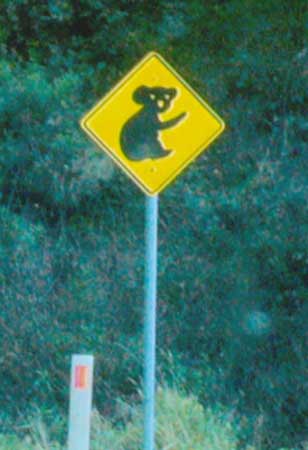
Adams, Peter. Numerous photographs.
Allen, Chris. National Parks Association Far South Coast Branch - Submission on IFOA Survey and Logging Protocols for Koalas in the Eden Region. Main Author: Chris Allen.
Dr Michael Archer, Dr Steven Cork, Dr Suzanne Hand, Stephen Phillips B.Sc., Malcolm Smith M.Sc., Edited by Leonard Cronin. Koala Australia's Endearing Marsupial 1987 Reed Books Pty Ltd.
Emmins, John Jeffrey. (The Victorian Koala (manuscript): Genetic Heterogeneity, Immune Responsiveness & Epizootiology of Chlarydiosis 1996 Thesis (PhD)-Monash University.
Houlden, Bronwyn. Low genetic variability of the koala Phascolarctos cinereus in south-eastern Australia following a severe population bottleneck" - Published in Molecular Ecology 1996, 5 269-281.
Clark, Judy. Australia's Plantations - A Report to the State Conservation Councils - Environment Victoria 1995.
Degabriele, Robert. Habitat, Vol 1, No. 2, Sept 1973 Koalas thrive in tropic haven.
Ecos 99 April - June 1999 p1
Kershaw, Jas. A. The Koala on Wilson's Promontory C.M.Z.S. The Victorian Naturalist Vol 51, July 1934
Lewis, F. The Rehabiltation of the Koala in Victoria The Victorian Naturalist Vol.70 March 1954
Lyndon, E. Koalas in the Gippsland Hills - Victorian Naturalist Vol. 68 August 1951
Menkhorst, Peter. ANHM Presentation: Managing Victoria's Koalas.
NRE Proposed Forest Management Plan for Gippsland - Natural Resources and Environment 2001.
Phillips, Stephen. 2000 Population Trends and the Koala Conservation Debate AKF 2000.
Phillips, Stephen. Callaghan, John. Tree species of koalas (Phascolarctos cinereus) in the Campbelltown area south-west of Sydney, New South Wales 2000.
Phillips, Stephen. Callaghan, John. Thompson, Valerie. The tree species preferences of koalas (Phascolarctos cinereus) inhabiting forest and woodland communities on Quaternary deposits in the Port Stephens area, New South Wales.
Tippet, Gary. Could YOU kill a koala? Sun 24/10/78.Troughton, Ellis. Furred Animals of Australia 1945?
Victoria's Koala Management Strategy 2004.
Zent, Susie. Numerous photos and personal communication.
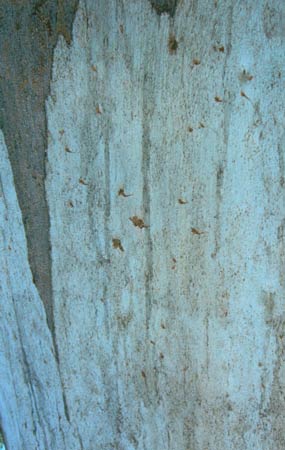
Probable Koala claw marks - Mountain Grey Gum Macks Creek catchment - July 2005
KOALA MANAGEMENT AND RESEARCH PROGRAM *
OCTOBER 2002 Judy Alexander – Stewardship Forester
AUSTRALIAN KOALA FOUNDATION CONFERENCE ON THE STATUS OF THE KOALA IN 2002
How the Past Affects the Koala’s Future Ballarat November 2002
1 NATIVE VEGETATION MAPPING
Hancock Victorian Plantations are carrying out native vegetation mapping of their entire estate. The native vegetation mapping project is a complex, labour intensive project which will eventually see HVP with the best vegetation data in the State.
1.1 Project Description:
1.1.1 Information gathered:
The information being gathered is quite extensive. The first level of information identified is the Ecological Vegetation Class according to EVC Descriptions developed by DNRE Botanists. The second level is to identify the dominant species present (similar to the DNRE SFRI process). The third level is to classify the age structure of the stand according to the canopy structure. This is presented as apercentage of either Over Mature, Mature or Regrowth present in the stand. The fourth level of information reflects the disturbance history, i.e. if the site has been cleared, has had a fire, has had heavy animal grazing etc.
1.1.2 Specifications:
The initial work is done on aerial photographs at a scale of 1:15,000. Once initial linework has been completed, at least 60% of the polygons are field verified, with an increased emphasis placed onthreatened EVC’s.It is estimated that this program will take 5 years to complete across the State. We have commenced this mapping in Gippsland on the Grand Ridge Plantations’ Estate.
1.2 How does this involve the Koala?
Through Grand Ridge Plantations’ involvement with the Australian Koala Foundation (AKF), this mapping will play a critical role in enabling the AKF to develop a Koala Habitat Atlas for the Strzelecki Ranges, which has the genetically significant Strzelecki Koala.
2 GRAND RIDGE PLANTATIONS AND THE AKF
In March 2000, the AKF entered into an agreement with Hancock Victorian Plantations (HVP). This basically saw the AKF visiting the Strzelecki Ranges and carrying out field surveys on a number of sites in an attempt to identify the preferred feed species of the Strzelecki Koala (given the highly modified andvariable nature of the Strzelecki Ranges). This information, combined with the vegetation mapping, willenable the AKF to develop a Habitat Atlas for the HVP Estate in the Strzelecki Ranges.
3 KOALA MANAGEMENT IN THE STRZELECKI RANGES
Grand Ridge Plantations has a number of Koala projects in action in the Strzelecki Ranges.
3.1.1 Permanent Plots
Grand Ridge Plantations have set up a number of Koala Permanent Plots. These have been located inareas where the Koala is known to occur, some of these are in proximity to harvesting areas. This willallow us to monitor the presence of the Koala (long term) adjacent to harvested areas. This will give us an idea of the impact of harvesting adjacent to Koala populations. These plots are measured annuallyvia an established scat search methodology.
3.1.2 Community involvement in Koala management
Grand Ridge Plantations encourages community involvement in its management of Koalas. Thanks tocommunity based volunteers, we have nearly 200 Koala sites recorded in our Flora and FaunaDatabase. This information is invaluable, as it enables us to target areas with known records forsurveying. In recognition of the community’s passion for the Strzelecki Koala, we enable them to beinvolved in surveys and permanent plot measurements and make information available to them.
3.1.3 Surveying contentious areas
Grand Ridge Plantations have carried out thorough Koala surveys in areas where there is a suspected high level of use within the plantations. One such survey was carried out in the head waters of BennettsCreek in the Jeeralangs. This was done to establish the degree to which the Koalas in this location weredependent on the E. viminalis plantations. It was identified that this area was a high use area, and theremaining E. viminalis plantation was reserved from harvesting on that site.
3.1.4 Koala PhD
Monash University and Grand Ridge Plantations are trying to attract a student to undertake a PhD on Koalas. The project brief for this PhD is outlined below.
Assessing habitat quality and koala demographics in planted and natural forests in the Strzelecki Ranges.
Project brief
Little natural forest remains in much of the Strzelecki Ranges and lowlands of West Gippsland (South-eastern Highlands and South-east Coastal Plain bioregions), and planted areas (Landcare andcommercial plantations) may form a major potential resource for wildlife in the region.This project will assess habitat quality and establish the demographics of koala populations in two forest blocks in the Strzelecki Ranges. Each block will be chosen so as to represent a mosaic of vegetation types (planted and natural forest types, of various ages and species) with varying silvicultural activitiesoccurring within or adjacent to the blocks.Patterns of use, by koalas, of the different vegetation types will also be recorded, and the effect of variables such as type of forest (planted pine, planted eucalypt, natural remnant), age of forest, distancefrom various silvicultural activities (harvesting, thinning) on forest use by koalas will be assessed.Information gained from the project will allow an understanding of the use of planted forests by koalas,and the effect of silvicultural practises on forest use by koalas.
Data resulting from the project will allow practical changes to the design of new Landcare or commercial plantings within the regional landscape in order to improve their contribution to conservation. Suggestions for the management of silvicultural activities in order to reduce negative impacts on wildlife will also result from this work. The project will provide a guide to help plantation managers contribute to regional biodiversity goals, including theregional priority of conserving remnant vegetation.
More information on PhD: Dr. Wendy Wright Senior Lecturer, School of Applied Sciences, Monash University, Gippsland wendy.wright@sci.monash.edu.au
phone: (03) 51 34 3433
3.1.5 Koala Management Plan
It is Grand Ridge Plantations’ intention to write a Koala Management Plan for the Strzelecki Ranges.This will heavily utilise the Habitat Atlas developed by the AKF, to assist with management decisions.